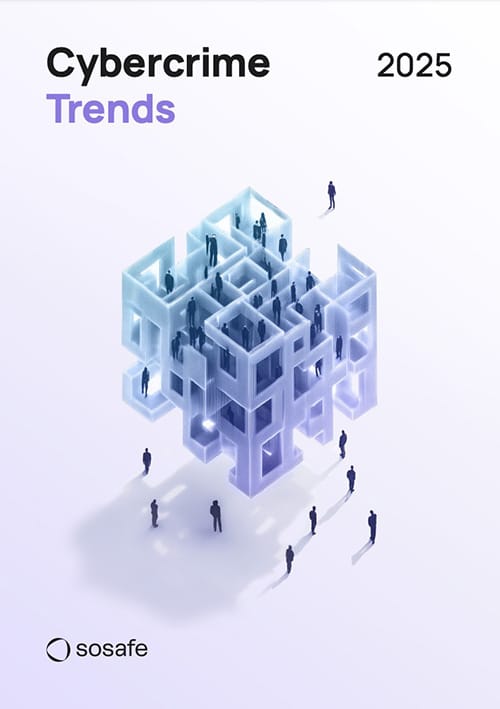Discover how our phishing simulations turn your employees into active defenders of your organisation.

Behavioral Science, Human Risk Management
Gamification in e‑learning: Enhancing the online learning experience
No time to read? Listen instead:
Games have been part of human culture and human nature since time immemorial and have helped us tear down physical limitations with a common goal of achieving victory. In the modern era, this commitment to winning found another purpose with a slightly more serious objective. At a time when it was believed that formal intelligence within a tutorial-based setting determines performance, gamification put this theory to the test – and tipped the scales in its favor as it introduced gamified e-learning.
But what is gamification exactly? Gamification refers to the application of game mechanics onto non-game contexts, like e-learning, to sharpen human performance to achieve goals. Personalized, creative, and relevant – organisations have found a new way to replace digital fatigue with dynamic learning and development. Instead of downplaying the importance of upskilling employees, gamified e-learning essentially changed the whole game. Combining factors like learning paths, strategies, motivators, evaluation methods, and entertainment, gamification created a compound effect to prove that learning is more than classroom diligence. Everything from design, setting ambitious objectives, and adding the right components, to user interaction, game design makes e-learning engaging, entertaining, and effective. With instant and quantifiable results, this approach has enhanced digital training, activating users to develop better habits that stick.
In the context of employee training, gamified elements are also replacing traditional techniques of teaching that generate disinterest and are unsuccessful in keeping up with the evolving educational landscape. This is not to suggest that gamification is completely disconnected from pedagogical principles. In fact, the juncture of teaching and learning with gamification is the sweet spot for e-learning success.
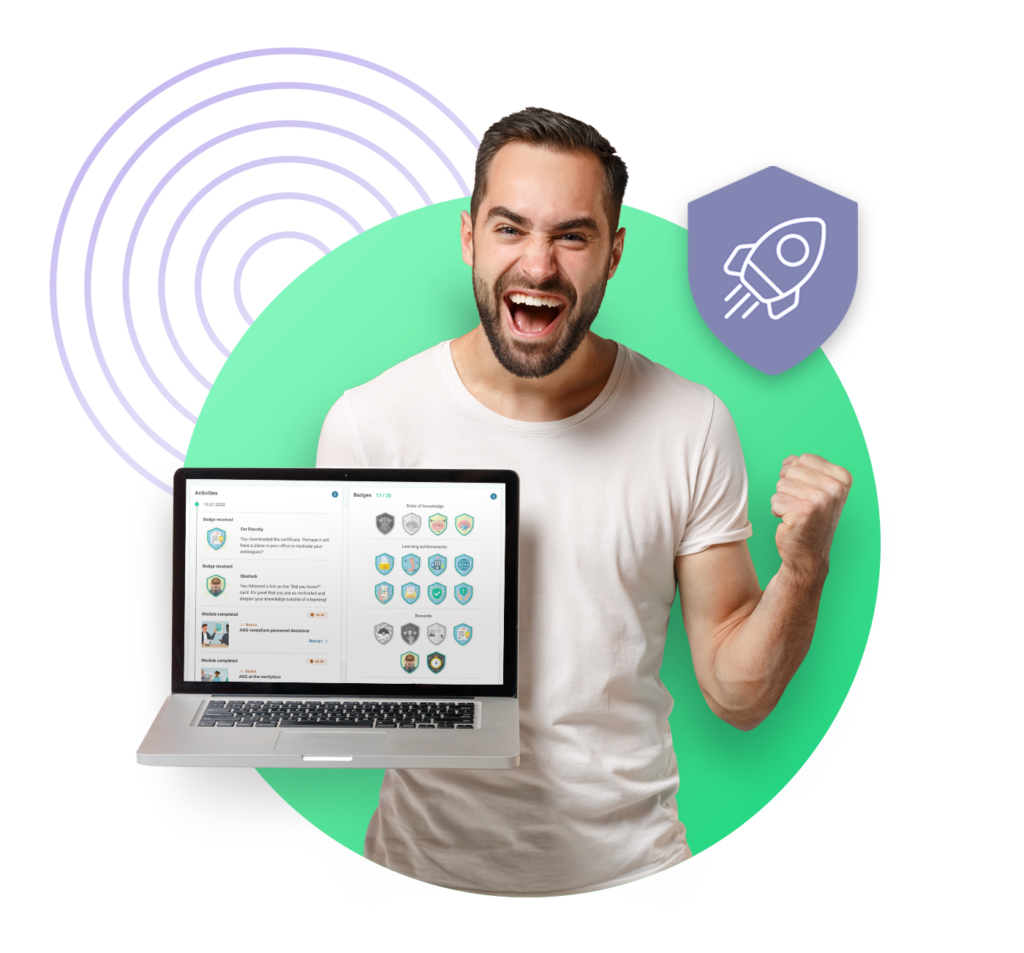
The science behind why gamification works
Humans are innately wired to positively react to reward. The concept of recognition activates the incentive system of our brain and motivates us to repeat the associated habits. This natural disposition to reward stimuli is efficiently harnessed by experiences that are coupled with recognition. Games introduced and mastered this strategy, as they continuously leverage the creative process by introducing us to newer experiences of performance-based rewards. But what if the experience could contribute to something greater than itself?
Today, game-based programmes have proven to be an innovative growth driver for e-learning with an extremely high motivation potential. Duolingo, for example, offers 39 languages to more than 500 million total users. And not in any conventional classroom – not a brick-and-mortar one at least. What keeps 40 million users returning to the platform every month? Their use of gamification combined with digital learning. Based on the Octalysis framework, designed by Yu-kai Chou, which identifies the driving forces that keep users engaged and entertained, Duolingo has added addictive elements inspired from games to build a positively productive experience. Opinions toward their notorious notifications may be more divided, but reception toward the product itself is unanimous. The entire process teaches you, encourages you, rewards you, and makes you want to return to the app. The momentum is maddening.
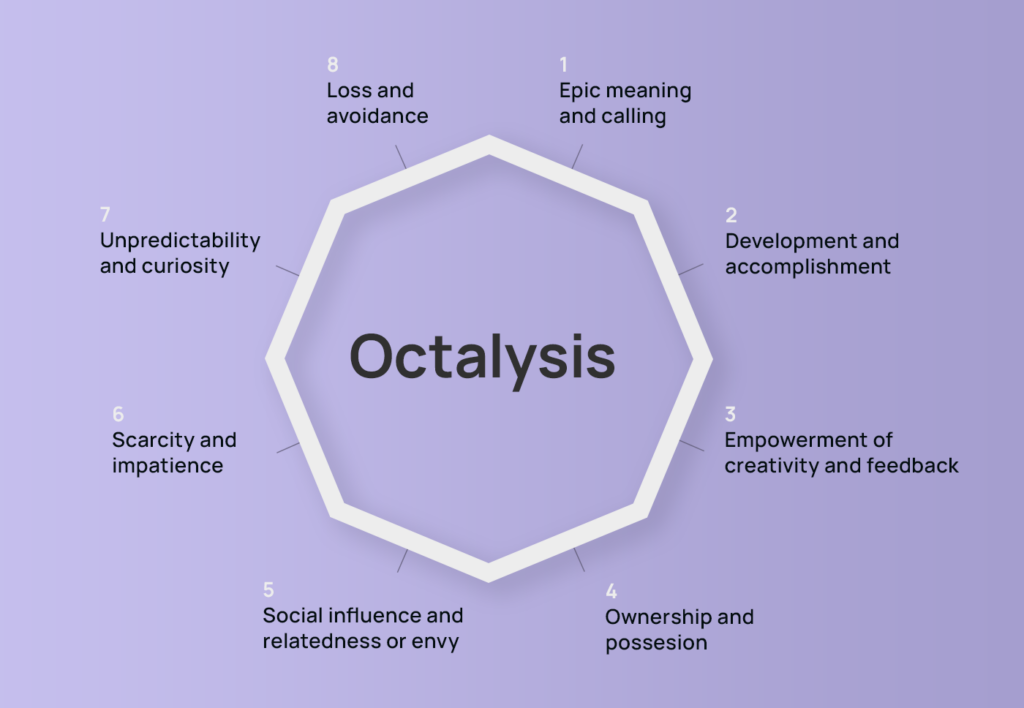
“The craft of deriving all the fun and addicting elements found in games and applying them to real-world or productive activities. This is what I call ‘Human-Focused Design’ as opposed to the ‘Function-Focused Design.’”
Yu-kai Chou
With a projected CAGR of 25.1% between 2021 and 2025, gamification is not just here to stay, but is here to revolutionize e-learning. For companies that require employees to update their knowledge, gamified e-learning reinforces important habits through self-guided learning with progressive training modules. This offers an environment where employees can work autonomously and monitor their learning paths on their own. This innovative process hones their skills of time management, conflict resolution, and organisation into a self-administered journey, by offering data-driven visualizations of their achievement. The narrative’s life cycle that navigates the user from beginning to end also allows the employee to explore modules, gain knowledge, and test this knowledge with varying levels of challenges.
Gamification is itself a motivational structure, the design and aesthetics of which add sensory satisfaction, naturally tying into the objectives of the programme. Adding a human touch to an otherwise stagnant e-learning, the thrill of winning is the driving force behind immersive, impactful learning experiences. Employees craving creativity can now be handed a game to play in exchange.
Gamification elements and their psychological principles
If the gamification approach was ever neglected as generic before, randomized without any conclusive evidence of its relation to human psychology, that’s no longer the case today. In a survey conducted by Talent LMS, an intuitive training platform, just 28% of employees felt motived after a non-gamified training programme whereas 83% felt motivated after completing the gamified equivalent.
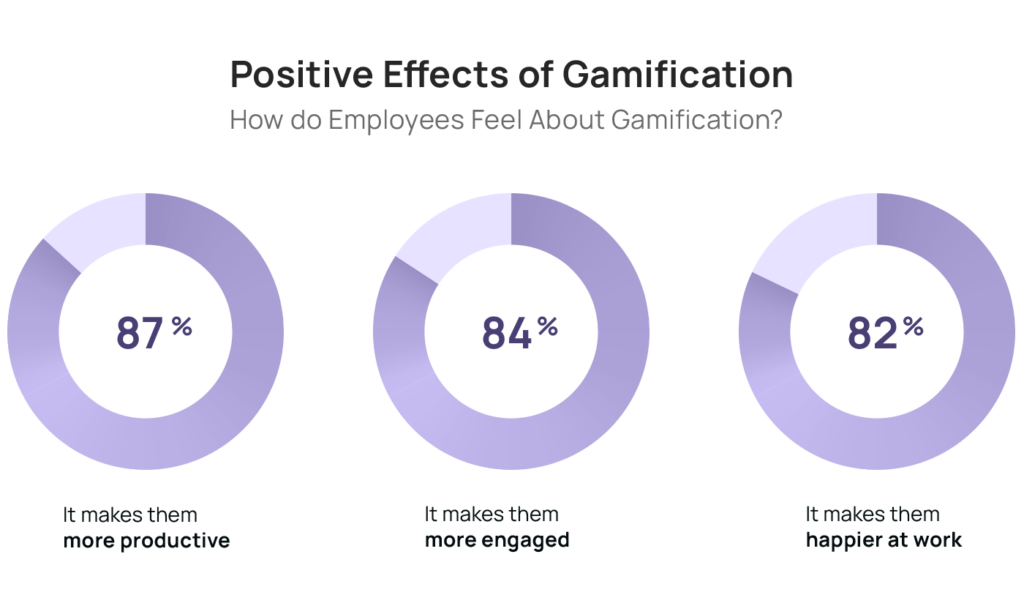
Findings show that using gamified elements fulfills certain psychological needs. Human psychology is a pivotal part of designing e-learning courses that communicate the right message. Knowledge retention, performance, and efficiency can be imbued in such an experience that pairs with psychology from the beginning.
The authors of ‘For the Win: How Game Thinking Can Revolutionize Your Business’, Kevin Werbach and Dan Hunter, categorized 15 elements, from what can otherwise be an exhaustive list, that have an important interplay within gamification. They also mention that these can work in parallel and overlap. However, it is important to assign them arbitrary characteristics to be able to understand their impact. According to the theory of self-determination, humans’ growth tendencies are based on three fundamental, intrinsic, psychological needs:
- Competence: The feeling of being proficient as humans interact with the environment.
- Autonomy: The freedom to make decisions based on one’s desires for different courses of action.
- Social connection: The sense of belonging and attachment to another person or group.
When mapping these intrinsic needs to game-based elements, it is interesting to learn which of these elements can be impacted with which psychological need. Let’s take a closer look at the five most popular ones.
Make phishing attacks miss the mark
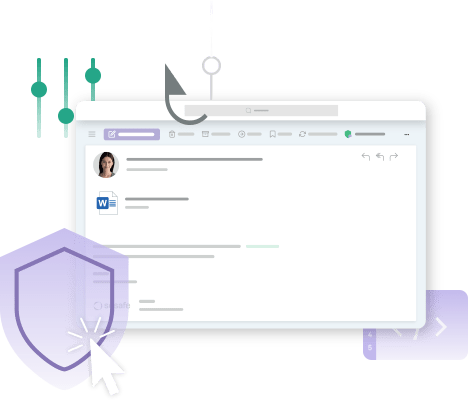
1. Points = Reward
Competence
Points are a straightforward way to reward the learners after a successful lesson or activity. They provide learners with granular feedback and highlight their progress which functions as an additional motivator. By indicating how the user is progressing, points allow for performance to be measured and in many ways influence the decisions of the user. Rewarding users by promoting them to the next levels also highlights well-earned achievements.
Underlying principle: The honeypot of rewards at the end of the rainbow is what we are all after. A systematically planned and organized reward system in a strategic set-up keeps us hooked on incremental doses of recognition.
2. Story = Entertainment
Autonomy; Social connection
People inherently love stories. So, naturally, being part of one evokes volitional participation. An immersive storyline within gamified e-learning generates curiosity and arouses the learners’ interest to keep learning. Users can experience their role within that story, whether the choices work in their favor or teach them something in return. This role-playing scenario can enrich the experience where users can choose their options and impact outcomes.
Underlying principle: People like a good narrative, especially when they get to choose the next path. Crafting a captivating story that contextualizes them with other characters for competition or conflict resolution nudges them to discover how it ends.
3. Challenges = Altruism
Competence; Social connection
Overcoming obstacles makes us feel great but helping others in overcoming theirs makes us feel even better. Simulations are packed with levelled challenges for users to unravel. To make the story even more interesting, users are encouraged to select certain paths that lead them to not only solving their own challenges, but also to getting an opportunity to be able to assist others, either teammates or characters of the story.
Underlying principle: Helping people makes us feel better about ourselves. Gamification addresses this need by encouraging learners to help others. Acknowledging the learners’ achievements along the way boosts their motivation to help other colleagues or characters who are in the game with them.
4. Progress bar = Achievement
Competence
A simple progress bar emphasizes users’ own growth over time. In order to complete the bar, learners are motivated to continue improving and self-evaluating their participation. Instead of comparing their performance to the rest, the progress bar is often a reflection of where the user is standing taking their own reference point. This sense of progress motivates them to continue learning.
Underlying principle: People want to make progress in life and aspire to become better and perform better. Progress bars and levels create the impression of achievement, development, and success.
5. Badges = Acknowledgement
Competence
Badges are an effective way of visually representing a person’s merit or success. They can serve as digital status symbols, achieved goals, or periodic acknowledgment indicators, all within a cumulative assessment. The desire to collect badges, especially if they are difficult to earn, instigates a sense of competence and motivates the users to continue undertaking challenges.
Underlying principle: Pride in one’s achievements is part of human nature. Badges address the psychological need for recognition, as this makes one’s own success visible to oneself (and occasionally to other users).
Gamification and cyber security: How do they fit?
The human factor, constantly underestimated and overlooked, plays a critical role in cyber security. Cybercriminals are persistently on the watch to infringe this neglected entry point to many organisations, commonly exploiting emotions such as trust, praise, or curiosity as bait. To address this mounting need for security awareness, organisations need to keep up to stay ahead. This means enabling their first line of defence, employees, to recognise potential threats and take the right steps to mitigate any impending risks – but more than that, to deter these threats altogether. Despite technical filters, it is not always possible to prevent unsolicited emails, such as phishing attempts, from reaching employees’ inboxes. Cyber security awareness training challenges employees to acquire and apply knowledge to do just that. It uses game-based design to educate users on risks resulting from human error and poor email security practices.
When you take an industry that is not traditionally associated with gaming, cyber security being far from it, and add game mechanics to scale user awareness – it surprisingly, but successfully serves the purpose of replacing any negative emotions that may be associated with security awareness, even instilling positive behaviour. Gamification of cyber security training takes users through an educational journey, complete with a compelling narrative, levelled challenges, and of course, well-earned incentives. This user-friendly strategy can innovatively educate employees on complex security topics, effortlessly. Content can be flexibly adapted to address cyber security issues and, in many cases, customized to fit the company brand. This form of gamification that switches drip-fed information with immersive storytelling has a massive impact on employee participation, activating them as security-aware users. A key component of cyber resiliency, gamification in e-learning from a trusted company makes a big difference in turning employees into active defenders.
For example, SoSafe awareness training, with immersive storytelling and deep gamification, demonstrably increases user engagement to 54%.
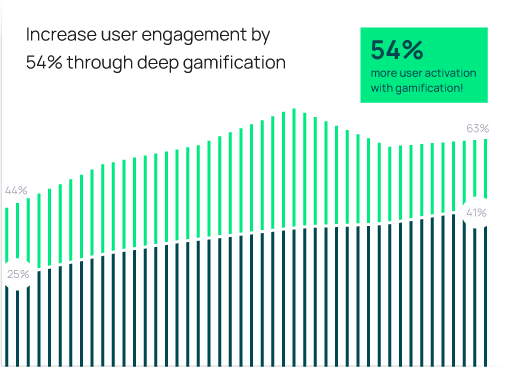
Awareness building with SoSafe e-learning
Gamification should be consciously and purposefully used to complement web-based training in a meaningful way. By integrating gamification elements, the human instinct to play can be stimulated in company e-learning programmes. It is an effective strategy to challenge employees consistently and continuously to spot and stop potential threats from wreaking havoc. The effects of cyber threats have the potential to snowball to dangerous proportions and result in critical consequences. To circumvent such cases from happening, gamified simulations engage users from recognizing the early signs to disrupt the threat from spreading. Think of it as an early, essential step in protecting organisations. Our Gamification white paper elabourates on how organisations can design user-centric content that generates engagement and makes a lasting impact. In the context of cyber security awareness training for example, this is a win-win situation because both the organisation and the employees benefit from a learning environment that is informative, rewarding, and effective.
Another important factor in driving engagement is personalization. When individuals see themselves reflected in the content, they’re more likely to engage, as it directly addresses their needs and interests. SoSafe has thoughtfully integrated both personalization and gamification into the development of our e-learning. By tailoring learning paths and avoiding the repetition of lessons learners already know, SoSafe offers engaging experiences that help companies build a lasting cyber security culture in an enjoyable way.
Take a look at SoSafe’s product to learn how your organisation can embark on a gamified security awareness journey.





















